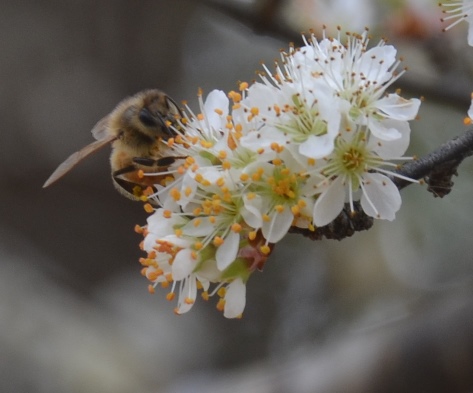Cross pollination is carried on mainly by insects, especially by honeybees, bumblebees, and to a very limited extent, other bee-like insects. The honeybee, of all insects, is most peculiarly adapted to the task of cross pollination.
Most insects are dormant during the winter period and in spring come out only in small numbers, until increasing generations have reestablished the dominance of the species. The honeybee, however, lives over in large numbers among the combs of the beehive where they cluster together during cold weather, consuming the honey stored in the combs during the previous season to furnish heat and energy during the winter period. Early in the spring, the queen bee begins to lay eggs and new bees begin to grow. The urge for food has assumed sizable proportions when fruit blooms arrive.
Bees gather nectar and pollen from flowers for their own use, and cross-pollination is entirely incidental to this search for food. Of all the insects visiting flowers, the honeybee is the best adapted to act as a carrier of pollen.
Source: Pollination for the Home Gardener, by Howard Veatch
The body and legs are covered with heavy, branched hairs which catch and hold the pollen grains. The hind legs of the honey bee have structures called “pollen baskets” which are spaces fringed with long curved hairs. The bee collects pollen which will be a major protein food source for the emerging young bees in the hive. If the bees brush against the stigma of the next flower it visits and inadvertently brushes off some of the pollen grains held in her body hairs, the act of cross-pollination will be completed.
According to a white paper on the health of U.S. Beekeeping, the American Association of Professional Apiculturists (AAPA) states: “Honeybees provide essential pollination services to U.S. fruit, vegetable and seed growers, adding $8-14 billion annually to farm income and ensuring a continuous supply of healthy affordable food for the consumers. About two million colonies are rented by growers each year to service over 90 crops.”
Key to a successful pollination enterprise (from “Storey’s Guide to Keeping Honey Bees”) :
- Maintain strong colonies so an optimal number of foragers is continuously available.
- Know intimately the requirement of each crop to be pollinated.
- Develop a system for moving colonies quickly and efficiently.
- Insist on a signed contract.
- Recognize that honey production and commercial pollination may be mutually exclusive.
For more information please see the following sources used for this article:
Beekeeping in the Panhandle – Publications
Pollination for the Home Gardener by Howard Veatch
“Storey’s Guide to Keeping Honey Bees” by Malcolm T. Sanford and Richard E. Bonney
“The Care and Keeping of Bees” by Norman Gary, PHD
- Things to Consider When Moving Honey Bee Hives - May 29, 2015
- Honeybees are Valuable Pollinators - December 19, 2014
- Manage Honey Bees Now to Prepare for Next Year’s Nectar Flow - August 1, 2014

